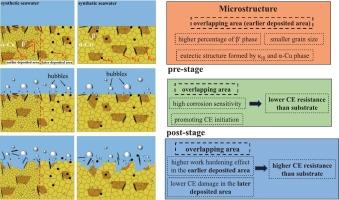Microstructure and cavitation erosion behavior in overlapping vs. substrate areas of WAAM NAB
IF 9.7
1区 化学
Q1 ACOUSTICS
引用次数: 0
Abstract
This study investigated the mechanism of influence of the microstructure of nickel-aluminum bronze (NAB) alloy prepared by wire-arc additive manufacturing (WAAM) on cavitation erosion (CE) and the synergistic effect of CE and corrosion. Microstructural analysis revealed that the earlier-deposited area in the overlapping area exhibited finer grain size (6.8 µm), higher β’ phase content (34.6 %), and dominant κⅢ/κⅣ precipitates, while the substrate featured coarser grain size (13.6 µm) and lower β’ phase content (23.2 %) featured coarser grain size (13.6 µm) and lower β’ phase content (23.2 %). CE testing indicated that in synthetic seawater, the cumulative mass loss in the overlapping area (75.2 mg) is lower than that in the substrate (82.32 mg), but the initial mass loss rate is faster. After CE, the alloy develops a 140 µm work-hardening layer, with peak hardness occurring at a depth of 20 µm. The synergistic effects of CE-corrosion accounted for 52 % of the total mass loss, with corrosion-promoted CE (34 %) exceeding CE-promoted corrosion.

WAAM NAB叠合与衬底区域的微观结构及空化侵蚀行为
研究了线弧增材制造(WAAM)法制备的镍铝青铜(NAB)合金的显微组织对空化腐蚀(CE)的影响机理以及空化腐蚀与腐蚀的协同效应。显微组织分析表明,叠合区沉积较早的区域晶粒尺寸更细(6.8µm), β′相含量更高(34.6%),κⅢ/κⅣ析出物占主导地位,而基体晶粒尺寸更粗(13.6µm), β′相含量更低(23.2%),晶粒尺寸更粗(13.6µm), β′相含量更低(23.2%)。CE测试表明,在合成海水中,重叠区域的累积质量损失(75.2 mg)低于基质中的累积质量损失(82.32 mg),但初始质量损失速率更快。CE处理后,合金形成140µm的加工硬化层,硬度峰值出现在深度为20µm的地方。CE腐蚀的协同效应占总质量损失的52%,其中腐蚀促进CE(34%)超过CE促进腐蚀。
本文章由计算机程序翻译,如有差异,请以英文原文为准。
求助全文
约1分钟内获得全文
求助全文
来源期刊

Ultrasonics Sonochemistry
化学-化学综合
CiteScore
15.80
自引率
11.90%
发文量
361
审稿时长
59 days
期刊介绍:
Ultrasonics Sonochemistry stands as a premier international journal dedicated to the publication of high-quality research articles primarily focusing on chemical reactions and reactors induced by ultrasonic waves, known as sonochemistry. Beyond chemical reactions, the journal also welcomes contributions related to cavitation-induced events and processing, including sonoluminescence, and the transformation of materials on chemical, physical, and biological levels.
Since its inception in 1994, Ultrasonics Sonochemistry has consistently maintained a top ranking in the "Acoustics" category, reflecting its esteemed reputation in the field. The journal publishes exceptional papers covering various areas of ultrasonics and sonochemistry. Its contributions are highly regarded by both academia and industry stakeholders, demonstrating its relevance and impact in advancing research and innovation.
 求助内容:
求助内容: 应助结果提醒方式:
应助结果提醒方式:


